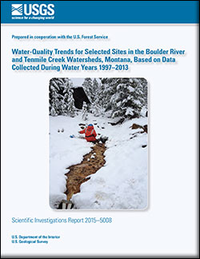Water-quality trends for selected sites in the Boulder River and Tenmile Creek watersheds, Montana, based on data collected during water years 1997-2013
Links
- More information: USGS Index Page
- Document: Report (4.92 MB pdf)
- Appendixes:
- Download citation as: RIS | Dublin Core
Abstract
In the Boulder River and Tenmile Creek watersheds in southwestern Montana, there was intensive mining during a 40-year period after the discovery of gold in the early 1860s. Potential effects from the historic mining activities include acid-mine drainage and elevated concentrations of potentially toxic trace elements from mining remnants such as waste rock and tailing piles. In support of remediation efforts, water-quality monitoring by the U.S. Geological Survey began in 1997 in the Boulder River and Tenmile Creek watersheds and has continued to present (2014). The U.S. Geological Survey, in cooperation with the U.S. Forest Service, investigated temporal trends in water quality at 13 sites, including 2 adit (or mine entrance) sites and 11 stream sites. The primary purpose of this report is to present results of trend analysis of specific conductance, selected trace-elements (cadmium, copper, lead, zinc, and arsenic), and suspended sediment for the 13 sites.
Trend results for most stream sites in the Boulder River watershed for water years 2000–13 (water year is the 12-month period from October 1 through September 30 and is designated by the year in which it ends) indicate decreasing trends in flow-adjusted specific conductance, in flow-adjusted concentrations (FACs) for most filtered and unfiltered-recoverable trace elements, and in suspended sediment. Overall, magnitudes of the decreasing trends in FACs of metallic contaminants are largest for Bullion Mine tributary at mouth (site 3), Jack Creek at mouth (site 4), and Cataract Creek at Basin (site 8). For sites 3, 4, and 8, magnitudes of decreasing trends generally ranged from about -5 to -10 percent per year. Notably, the watersheds upstream from sites 3, 4, and 8 have been targeted by substantial remediation activities. Consideration of trend patterns among all stream sites in the Boulder River watershed provides strong evidence that remediation activities are the primary cause of decreasing trends in metallic contaminants.
Trend results for sites in the Tenmile Creek watershed generally are more variable and difficult to interpret than for sites in the Boulder River watershed. Trend results for Tenmile Creek above City Diversion (site 11) and Minnehaha Creek near Rimini (site 12) for water years 2000–13 indicate decreasing trends in FACs of cadmium, copper, and zinc. The magnitudes of the decreasing trends in FACs of copper generally are moderate and statistically significant for sites 11 and 12. The magnitudes of the decreasing trends in FACs of cadmium and zinc for site 11 are minor to small and not statistically significant; however, the magnitudes for site 12 are moderate and statistically significant. In general, patterns in FACs for Tenmile Creek near Rimini (site 13) are not well represented by fitted trends within the short data collection period, which might indicate that the trend-analysis structure of the study is not appropriate for describing trends in FACs for site 13. The large decreasing trend in FACs of suspended sediment is the strongest indication of change in water quality during the short period of record for site 13; however, this trend is not statistically significant.
Study Area
| Publication type | Report |
|---|---|
| Publication Subtype | USGS Numbered Series |
| Title | Water-quality trends for selected sites in the Boulder River and Tenmile Creek watersheds, Montana, based on data collected during water years 1997-2013 |
| Series title | Scientific Investigations Report |
| Series number | 2015-5008 |
| DOI | 10.3133/sir20155008 |
| Year Published | 2015 |
| Language | English |
| Publisher | U.S. Geological Survey |
| Publisher location | Reston, VA |
| Contributing office(s) | WY-MT Water Science Center |
| Description | Report: x, 46 p.; Appendix 1 tables; Appendix 2 table; Appendix 3 tables; Appendix 3 figures |
| Time Range Start | 1996-10-01 |
| Time Range End | 2013-09-30 |
| Country | United States |
| State | Montana |
| Other Geospatial | Boulder River watershed, Tenmile Creek watershed |
| Datum | North American Datum 1983 |
| Projection | Lambert Conformal Conic projection |
| Online Only (Y/N) | Y |
| Additional Online Files (Y/N) | Y |


